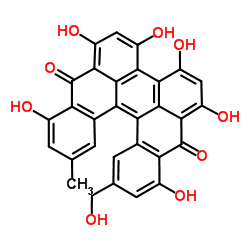Protopseudohypericin
Modify Date: 2025-08-25 16:14:17

Protopseudohypericin structure
|
Common Name | Protopseudohypericin | ||
|---|---|---|---|---|
| CAS Number | 54328-09-5 | Molecular Weight | 522.458 | |
| Density | 1.8±0.1 g/cm3 | Boiling Point | 1019.3±65.0 °C at 760 mmHg | |
| Molecular Formula | C30H18O9 | Melting Point | N/A | |
| MSDS | N/A | Flash Point | 584.0±30.8 °C | |
Use of ProtopseudohypericinProtopseudohypericin, a naturally occurring naphthodianthrone, is isolated from H. perforatum. Protopseudohypericin is considered to be the biosynthetic precursor of Pseudohypericin[1][2]. |
| Name | Protopseudohypericin |
|---|---|
| Synonym | More Synonyms |
| Description | Protopseudohypericin, a naturally occurring naphthodianthrone, is isolated from H. perforatum. Protopseudohypericin is considered to be the biosynthetic precursor of Pseudohypericin[1][2]. |
|---|---|
| Related Catalog | |
| References |
| Density | 1.8±0.1 g/cm3 |
|---|---|
| Boiling Point | 1019.3±65.0 °C at 760 mmHg |
| Molecular Formula | C30H18O9 |
| Molecular Weight | 522.458 |
| Flash Point | 584.0±30.8 °C |
| Exact Mass | 522.095093 |
| PSA | 175.75000 |
| LogP | 7.23 |
| Vapour Pressure | 0.0±0.3 mmHg at 25°C |
| Index of Refraction | 1.952 |
| Hazard Codes | Xi |
|---|
| Dibenzo[a,o]perylene-7,16-dione, 1,3,4,6,8,15-hexahydroxy-10-(hydroxymethyl)-13-methyl- |
| 1,3,4,6,8,15-Hexahydroxy-10-(hydroxymethyl)-13-methyldibenzo[a,o]perylene-7,16-dione |

